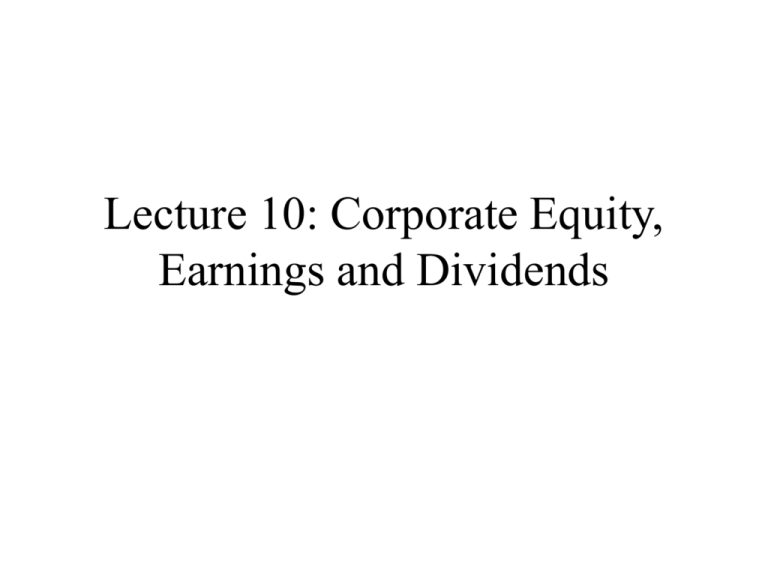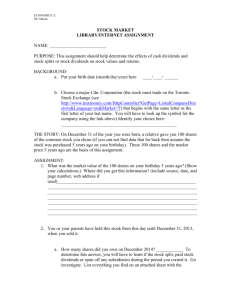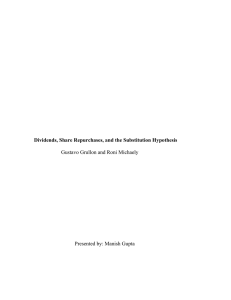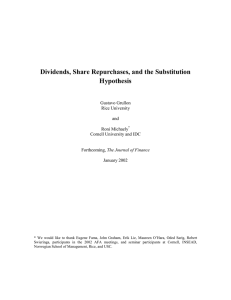Lecture 9: Corporate Equity, Earnings and Dividends
advertisement

Lecture 10: Corporate Equity, Earnings and Dividends The Corporation • [1611] A body corporate legally authorized to act as a single individual, an artificial person created by royal charter, prescription, or act of legislature, and having authority to preserve certain rights in perpetual succession. (OED) • Compare publicani of ancient Rome, essentially corporations (though the most prominent were private collecting agencies for taxes) For-Profit vs. Non-Profit • For-profit corporation is owned by shareholders, equal claim after debts paid, subject to corporate profits tax. • Non-profit is not owned, self-perpetuating directors. Not subject to corporate profits tax. Common vs. Preferred Stock • Common stock: dividend is at discretion of firm, subject to legal restrictions • Preferred stock: Specified dividend does not have to be paid, but firm cannot pay dividend on common stock unless all past preferred stock dividends are paid. • Corporate bonds: Firm is contractually obligated to pay coupons and there is a maturity date when principal must be paid. Limited Liability • Even publicani had some form of limited liability sometimes • New York State legislature made limited liability standard for all corporations, 1811 • Standard copied by other states, finally California, 1931. Other Corporate Obligations • Convertible bonds: bondholder has option to convert the bond to stock • Employee incentive options • Tracking stock • Junk bonds • Warrants • Partnership contracts Voting of Common Shares • Usually one share one vote, in person or by proxy, for board of directors and some other essential matters • Shareholders meetings usually annual event, and required by law for big events such as merging corporation • Shareholder meeting circuses Berle and Means • Adolf A. Berle Jr., and Gardiner C. Means, The Modern Corporation and Private Property, 1933 • Separation of ownership and control • “ownership is so widely scattered that working control can be maintained with but a minority interest.” • The “quasi-public corporation” is constrained by law to serve other interests. Payment of Dividends • • • • Purely discretionary Young firms typically pay none NASDAQ dividend yield virtually zero Corporate culture influences dividends. Microsoft • Liquidity constraints on dividends Modigliani-Miller Dividend Irrelevance Theory • Journal of Business, 1961. • Assume no taxes or transactions costs • Consider purely financial transaction: selling shares to pay dividends • M&M Conclusion: Dividend policy has no effect on the value of the firm. • Purely nominal difference between dividend checks and repurchase checks. Adding Taxes to M&M World • Dividends are taxable as personal income, share repurchases are capital gains, lower rate. • Announcing payment of new dividends should lower value of firm by present value of taxes. Why Do Firms Pay Dividends? • Hersch Shefrin and Meir Statman: Selfcontrol theory of dividends. (analogy to Christmas clubs, overwithholding) Rule of thumb spending rule. • Prospect theory interpretation: framing matters. Dividends framed as income. • University endowments once required highyield investments to provide income Dividend Signalling • By raising dividends, firm shows it can court bankruptcy. • Battacharya, Hakansson, Ross • Problem: alternative signalling methods are cheaper tax-wise Lintner Model of Dividends • DIVt-DIVt-1= ( × EPSt-DIVt-1) • =adjustment rate, 0< <1 • =target ratio, 0< <1 DIVt (1 ) k EPSt k k 0 Kahneman & Tversky Framing Example • “US is preparing for a rare Asian disease which is expected to kill 600 people.” • “If Program A is adopted, 200 people will be saved. If program B is adopted, there is a 1/3 probability that 600 people will be saved and a 2/3 probability that no people will be saved.” (Majority: A) K&T Framing Continued • Other respondents given a different choice: • If program C is adopted, 400 people will die If Program D is adopted, there is a 1/3 probability that no one will die, and a 2/3 probability tha 600 people will die.” (Majority: D) Scientific American 1981 General Public Utilities Corp • President Kuhn proposed to substitute stock dividends for cash dividends, and offered to sell the stock dividend for any stockholder for minimal transaction cost. (ca. 1968) • Direct saving to shareholder: $4 million a year. • Intense negative shareholder reaction S&P D/E & D/P 1871-2004 Share Repurchase • Once rare, now S&P 500 firms repurchase approx. 2% of shares per year. They issue about 1% of shares per year in employee option exercise, so net repurchase is about 1% per year. • Repurchase now almost as high as dividends paid, but firms still pay dividends. A puzzle. Reasons for Share Repurchase • Tax break for investors • Firms’ unwillingness to cut dividends, uncertainty that current earnings will continue • Price pop after a repurchase. Buybacks taken as a signal. But price pops are fading. • Now investors sometimes view repurchase as a sign that firm is “old economy.” NASDAQ firms less likely to repurchase shares, as if they think value is too high. Employee Options and Share Repurchase • The “overhang,” percent of stock market promised to employees via options, stood at 6.2% in 144 of largest S&P 500 firms in 1998. • Option holders have an interest in repurchasing shares rather than paying dividends. • Lambert Lanen & Larker JFQA 1985: dividend payouts reduced after option plans introduced. Reasons for Declining Dividend, Earnings Yield in New Millennium • Perception of great growth opportunities with new technology • First-mover advantage prized • Dividends, Earnings are for losers • Problem in valuing firms











